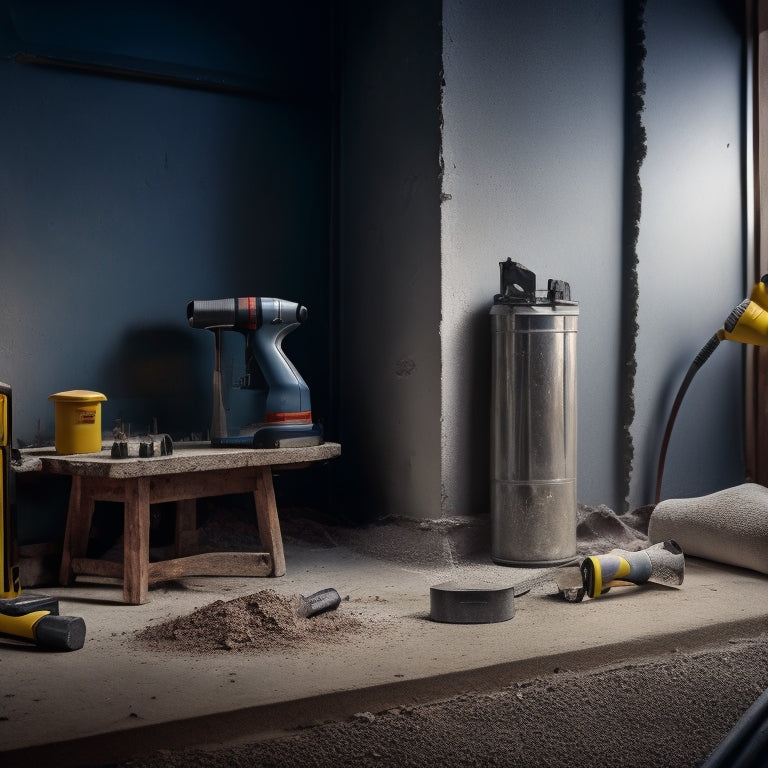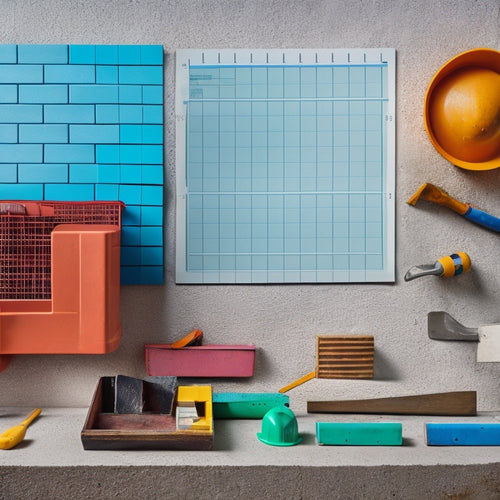
Essential Tools for Window Opening in Concrete Walls
Share
When opening a window in a concrete wall, you'll need a range of specialized tools to guarantee a safe and efficient operation. Demolition hammers, such as electric, pneumatic, and hydraulic types, are essential for controlled block extraction. Concrete cutting tools like diamond blade saws, wall sawing machines, and handheld concrete cutters will help you make precise cuts. Additionally, you'll need rebar cutting methods like abrasive cutting, shearing, and burning, as well as concrete drilling accessories and wall chasing equipment. Don't forget about safety gear and debris removal tools to keep your workspace clean and hazard-free. With these tools, you'll be well-equipped to tackle your window opening project - and by understanding their applications and subtleties, you can access even more precise and efficient results.
Key Takeaways
- Demolition hammers, concrete cutting tools, and rebar cutting methods are essential for window opening in concrete walls.
- Diamond blade saws, wall sawing machines, and handheld concrete cutters are necessary for precise concrete cutting.
- Rebar cutting methods, such as abrasive cutting and shearing, ensure accurate cuts and maintain structural integrity.
- Concrete drilling and chasing equipment, including drill bits and wall chasers, aid in precise hole creation and wall preparation.
- Safety gear, including hard hats and safety glasses, and safe demolition methods, such as risk assessments and ventilation, are crucial for a safe working environment.
Demolition Hammer Essentials
Demolition Hammer Essentials
Several demolition hammers are available on the market, but only a few meet the standards required for effective window opening. You'll need a hammer that can withstand the demands of breaking through concrete walls.
There are three primary demolition hammer types: electric, pneumatic, and hydraulic. Electric hammers are suitable for smaller projects, while pneumatic and hydraulic hammers are better suited for larger, more complex tasks.
When selecting a demolition hammer, consider the weight, power, and bit type. A heavier hammer with more power will be more effective at breaking through concrete. However, it may also be more difficult to handle. You'll need to strike a balance between power and manageability.
Proper demolition hammer maintenance is essential to guarantee peak performance and extend the tool's lifespan. Regularly inspect the hammer for signs of wear, clean the tool after each use, and store it in a dry place.
Additionally, follow the manufacturer's guidelines for bit replacement and maintenance. By choosing the right demolition hammer and following proper maintenance procedures, you'll be well-equipped to tackle window opening projects efficiently and effectively.
Concrete Cutting Tools Needed
You'll need concrete cutting tools to make precise cuts in walls and floors for window openings.
Your arsenal should include diamond blade saws for high-torque cutting, wall sawing machines for large-scale projects, and handheld concrete cutters for smaller, more intricate cuts.
Diamond Blade Saws
Several diamond blade saws are available on the market, each designed for specific concrete cutting tasks. You'll need to choose the right one for your window opening project.
There are three primary diamond blade types: segmented, continuous rim, and turbo. Segmented blades are ideal for aggressive cutting and removing large amounts of concrete, while continuous rim blades provide a smoother cut and are better suited for finishing work. Turbo blades offer a balance between the two.
When it comes to cutting techniques, you'll need to take into account the type of cut you're making. Are you making a straight cut, a curved cut, or a plunge cut? Different cutting techniques require different blades and approaches.
For example, a straight cut typically requires a segmented blade, while a curved cut may require a continuous rim blade. You'll also need to take into account the depth of the cut, the type of concrete you're working with, and the power of your saw.
Wall Sawing Machines
As concrete cutting projects become more complex, wall sawing machines emerge as essential tools for making precise, deep cuts in concrete walls. You'll need these machines to create window openings, doorways, or any other type of penetration in a concrete structure.
Wall saws are designed to provide precision cutting, allowing you to make accurate cuts with minimal waste and maximum control.
Wall sawing machines typically consist of a track-mounted saw that's specifically designed for vertical or horizontal cutting. The saw blade is usually a diamond-coated or abrasive wheel that's capable of cutting through reinforced concrete.
These machines are ideal for making large, precise cuts, and they're often used in conjunction with other concrete cutting tools, such as diamond blade saws.
When selecting a wall sawing machine, consider the type of project you're working on, the thickness of the concrete, and the desired level of precision.
You may also need to factor in the power source, as some machines are electric, while others are hydraulic or pneumatic.
Handheld Concrete Cutters
When precision cutting is required for smaller concrete cutting projects or areas inaccessible to wall sawing machines, handheld concrete cutters come into play. These portable tools allow you to make precise cuts in confined spaces, making them ideal for applications like window openings, doorways, and electrical conduit installations.
Handheld concrete cutters come in various types, including electric, hydraulic, and pneumatic models. Electric cutters are suitable for smaller projects and offer ease of use, while hydraulic and pneumatic cutters provide more power and are better suited for heavier-duty applications.
Portable cutting techniques, such as push-cutting and pull-cutting, enable you to make controlled, accurate cuts in concrete.
When selecting a handheld concrete cutter, consider factors like cutting depth, blade type, and power source. Diamond blades, for instance, are ideal for cutting through reinforced concrete, while abrasive blades are better suited for softer materials.
Block Removal Techniques
You'll need to employ safe demolition methods to avoid damaging surrounding structures or injuring yourself during block removal.
Controlled block extraction techniques are essential to guarantee that blocks are removed in a predictable and manageable manner.
Safe Demolition Methods
Most window openings require the removal of blocks or concrete to create an opening, which demands careful planning and execution to avoid damaging the surrounding structure.
As you prepare for block removal, it's crucial to conduct a thorough risk assessment to identify potential hazards and develop strategies to mitigate them. This includes evaluating the condition of the concrete, checking for any hidden utilities or structural elements, and determining the most suitable demolition techniques.
To guarantee safe work practices, you should always wear personal protective equipment (PPE) such as hard hats, safety glasses, and gloves.
Additionally, you should establish a safe working zone, free from debris and tripping hazards, and make sure that the area is well-ventilated to prevent exposure to dust and other airborne contaminants.
By following these guidelines, you can minimize the risk of accidents and secure a successful block removal process.
Controlled Block Extraction
Now that you've prepared the site and confirmed a safe working environment, it's crucial to focus on the controlled extraction of blocks. This critical step in window opening requires precision and care to avoid damaging the surrounding concrete.
You'll need to employ block extraction techniques that guarantee a controlled demolition process. To achieve this, you'll use specialized tools designed for block removal. These may include pneumatic hammers, demolition robots, or hydraulic splitters.
Each tool is suited for specific block types and sizes, so it's vital to select the right one for your project. When applying controlled demolition methods, you'll need to carefully analyze the block's structure and identify the most effective extraction points.
This might involve creating a series of relief cuts or using a demo hammer to dislodge the block from the surrounding concrete. By doing so, you'll minimize the risk of damage and guarantee a successful window opening operation.
Rebar Cutting Methods
The process of cutting rebar, a crucial step in window opening, requires efficient methods to guarantee accurate cuts and minimize waste. You need to confirm that the rebar is cut correctly to avoid compromising the structural integrity of the concrete wall.
To achieve precise cuts, you can employ the following rebar cutting methods:
-
Abrasive cutting: This method uses an abrasive wheel or blade to cut through the rebar. It's effective for cutting through thick rebar and is often used in conjunction with other methods.
-
Shearing: Shearing involves using a machine or tool to cut the rebar by applying a high amount of pressure. This method is ideal for cutting through thin rebar.
-
Burning: Burning involves using a torch to heat the rebar, causing it to weaken and break. This method is often used in combination with other methods, such as bending or tying.
- Cutting with a saw: This method involves using a specialized saw, such as a circular saw or a reciprocating saw, to cut through the rebar.
When cutting rebar, it's crucial to take into account the type of rebar, its thickness, and the desired cut. By choosing the right method, you can confirm accurate cuts and minimize waste, making the window opening process more efficient.
Concrete Drilling Accessories
You've successfully cut the rebar using one of the methods mentioned earlier, and now you're ready to move on to the next step in the window opening process.
To complete the core drilling, you'll need the right concrete drilling accessories. These include concrete drill bits designed specifically for drilling through concrete. These bits are made with tungsten carbide or diamond-coated edges, allowing them to withstand the abrasive nature of concrete.
When selecting concrete drill bits, consider the type of concrete you're working with, as well as the diameter and depth of the hole you need to drill.
Core drilling requires a steady, consistent motion, so it's crucial to choose a bit that's suitable for your drill and the task at hand. Additionally, make sure you're using the correct drilling technique to avoid damaging the surrounding concrete or the drill bit itself.
With the right concrete drilling accessories and proper technique, you'll be able to efficiently and accurately drill through the concrete, clearing the path for the next steps in the window opening process.
Wall Chasing Equipment
Three key components make up wall chasing equipment: a wall chaser, a dust extraction system, and a vacuum cleaner.
When preparing to create a window opening in a concrete wall, you'll rely on this equipment to execute efficient chasing techniques. Wall preparation is vital, and the right tools will help you achieve a clean, precise cut.
To guarantee peak performance, consider the following:
-
Wall chaser selection: Choose a wall chaser that suits the size and type of your project. Electric, pneumatic, or hydraulic options are available, each with its advantages and limitations.
-
Dust extraction system integration: A dust extraction system will minimize airborne particles and debris, improving air quality and reducing cleanup time. Verify the system is compatible with your wall chaser and vacuum cleaner.
-
Vacuum cleaner specifications: Select a vacuum cleaner designed for heavy-duty use, with sufficient suction power and a large dust container.
- Chasing technique enhancement: Experiment with different chasing techniques to find the most effective approach for your specific project, considering factors like wall thickness and material type.
Debris Removal Tools
Your debris removal tools play an essential role in maintaining a safe and efficient workspace during window opening projects. Effective debris collection and waste disposal are vital to preventing accidents and guaranteeing a smooth workflow.
You'll need a reliable vacuum system or dust collector to capture concrete dust and debris generated during the wall chasing process. Additionally, a heavy-duty broom or scraper is necessary for sweeping away larger chunks of concrete and dust from the floor.
A wheeled dustbin or debris container should also be on hand to collect and transport waste material to a designated disposal area. Moreover, a handheld vacuum or blower can be useful for cleaning up smaller areas and crevices.
Safety Gear Requirements
As you prepare for window opening projects, maintaining a safe workspace requires more than just efficient debris removal.
You must also prioritize personal protective equipment (PPE) and conduct a thorough risk assessment to minimize hazards.
To guarantee a safe working environment, consider the following essential safety gear:
-
Hard hats: Protect yourself from falling objects and debris with a sturdy hard hat that meets industry standards.
-
Safety glasses: Prevent eye injuries from flying particles and dust with shatter-resistant safety glasses.
-
Dust masks: Filter out airborne contaminants and concrete dust with a high-quality dust mask.
- Steel-toed boots: Guard your feet from heavy objects and sharp edges with sturdy, steel-toed boots.
Frequently Asked Questions
Can I Use a Regular Hammer for Window Opening in Concrete Walls?
You shouldn't use a regular hammer for window opening in concrete walls; instead, opt for specialized hammer types like claw hammers or lump hammers paired with concrete chisels to guarantee efficient and safe demolition.
How Do I Prevent Damage to Surrounding Concrete During Demolition?
When performing demolition, you'll prevent damage to surrounding concrete by employing controlled demolition techniques, avoiding over-breaking, and identifying concrete reinforcement to carefully isolate and remove it, ensuring a precise and safe process.
Are There Any Eco-Friendly Options for Debris Removal and Disposal?
You'll find eco-friendly debris removal and disposal options by opting for sustainable disposal methods, such as recycling concrete aggregates, and exploring green alternatives like repurposing materials or using biodegradable demolition aids.
What Is the Recommended Depth for Cutting Concrete When Creating an Opening?
When cutting concrete for an opening, you'll want to use advanced cutting techniques that guarantee a precise depth of 1-2 inches, taking necessary safety precautions to avoid structural damage and potential hazards.
Can I Reuse the Removed Concrete Blocks for Other Construction Projects?
When considering block repurposing ideas, you'll need to assess the removed concrete blocks' structural integrity concerns, as reusing them in other construction projects may compromise their load-bearing capacity, so it's essential to evaluate their condition before deciding to reuse or discard them.
Conclusion
You've got the essential tools for window opening in concrete walls at your fingertips, and it's time to put them to work. Like a surgeon with a scalpel, you'll precision-cut through concrete, rebar, and debris to create a seamless opening. With these tools, the concrete wall changes from an impenetrable fortress to a canvas awaiting your masterpiece. Now, get ready to break through and bring in the light.
Related Posts
-

10 Best Tools for Sealed Concrete Flooring on Budget
When starting on a sealed concrete flooring project on a budget, you'll need to prioritize essential tools without sa...
-

3 Best Hand Tools for DIY Concrete Construction
When tackling a DIY concrete construction project, you'll need three essential hand tools to achieve a professional-l...
-

Reinforcement Tools Checklist for Concrete Block Walls
You'll need a range of reinforcement materials, including horizontal and vertical rebar, fiber mesh, and anchor bolts...


